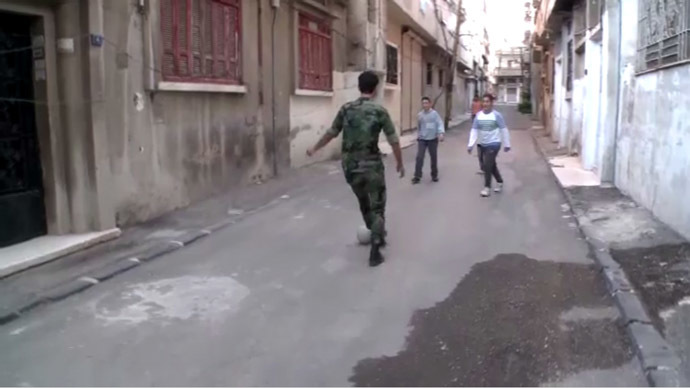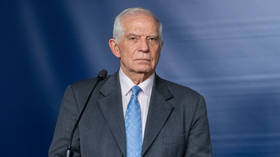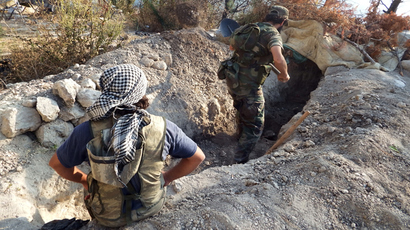Bitter lessons: Teacher-turned-soldier shows RT reporter around war-torn Homs
Bassam Shaaban, an art teacher in Syria’s Homs, traded his brush for a Kalashnikov and volunteered for National Defense Forces after a deadly rebel attack ravaged his school. He took an RT correspondent on a tour around the city devastated by war.
Twenty-nine-year-old Bassam is still haunted by memories of the
day two-and-a-half years ago when the war suddenly broke into his
classroom.
“I was teaching when a mortar shell landed in the
schoolyard,” he says. “There were a lot of victims. I
remember, as I held one little girl who had been killed and
seeing her blood, I felt sorry for her family. From then I knew I
had to get involved."
Now, the teacher-turned-soldier displays his expertise in the art
of war, as he confidently takes RT’s Paula Slier past a sniper
valley, saying that he is used to crossing it safely.
Homs has been the epicenter of the battle between government
forces and rebels since the very start of the conflict. For quite
a long time it was besieged by the rebels. Now they only control
parts of the old city, where about 3,000 people civilians live.
The army has managed to take most of Homs it back under its
control.
The military conflict saw much of the population flee. Only
one-fifth of it now remains in the city.
Bassam leads RT’s correspondent further on a tour around Bab El
Sham’, the army-controlled part of Homs, eventually stopping at a
church built in 1885, where the man once brought his children to
teach them about their homeland.

For 126 years it served as a
house of sanctuary – overnight it became a house of slaughter,
when it was attacked by rebel forces.
“The Syrian army wasn't based here, there was no military here
– only innocent civilians,” Bassam says. “Some people here were
praying for peace. This is one of the bombs that fell, one of the
bombs that caused all this devastation. This is their message –
we’ll put it here just as a reminder.”
It’s not the only Christian church attacked by militants in
Syria. The village of Maaloula, considered a symbol of Christianity in the
country was taken over by jihadists in September. Residents
claimed rebels resorted to looting, executions and forcing
residents to convert to Islam.
The Homs neighborhood of Bab El Sham’ is currently clear of
militants. But the National Defense Forces aren’t withdrawing to
prevent the terrorists from coming back.
“We are also trying to bring life back to this quarter. When
we defeat them we will rebuild this church and children will
return to play here and prayers will once again be heard
here.”
It seems like Bassam’s dream is starting to come true as a
handful of families have come back to the area. RT’s crew comes
across several children playing football with a Syrian army
soldier on one of the war-ravaged streets.

“I remember when I used to play football just like them,”
Sulimein, the soldier says. “And now I have to carry a gun
just so that they can keep playing safely. When I was their age I
dreamt of becoming a professional footballer and I’m sure they
have the same dream. We’re protecting them so nobody comes and
destroys their dreams.”
Twenty-year-old Sulimein volunteered to join his father in the
army although he didn’t have to do it as he is his parents’ only
son.
“He is the son of our country, not only my son,”
Sulimein's father proudly says. “In such a situation everybody
should stand by their country.”
And it seems like neither Sulimein nor Bassam will be able to say
farewell to their machine guns anytime soon.
The leading opposition group, the Syrian National Council, has
refused to participate in the Geneva II peace conference, which
is a significant blow to efforts by both the US and Russia to
find a way out of the civil conflict.
The capital Damascus was rocked by multiple bomb blasts on Sunday. Experts believe the recent
escalation of violence is an attempt by the talks–boycotting
opposition to further undermine international diplomatic peace
efforts.
As RT’s correspondent leaves Bassam, he asks her to pray for him
and his comrades. Most of them, he says, will probably not be
here the next time she visits.
For more on the situation in Homs watch RT Paula Slier’s report
from the war-ravaged city.














